Taking Care of Your Core, Before and After Baby – And my Mutu Review
A while ago I mentioned that I was doing Mutu and promised that I would give you a review when I was done. The review is below. Whether or not you do Mutu, however, I’ve learned the importance of taking care of one’s midsection. I was motivated to get back in shape specifically because I hope to have more kids and I want to be strong and healthy while growing a family — in particular, I want to keep my core strong and healthy, since it’s the core that undergoes so much during childbearing! It’s worth knowing that there are things you can do before, during, and after having babies to get this strength.
We’re not exactly fitness girls over here at LMLD. We like to eat good food and go on walks (and some of us enjoy running more or less occasionally). But we’re not the type to jump on a workout program in normal circumstances. We’re not sprinting up mountains or heading for the Crossfit joint anytime soon.
But, even so, we recognize that it’s important to take care of yourself physically. And that it fits into our vocation as wives and mothers to do the best we can to keep strong and fit. This Mutu program appealed to me so much specifically because it’s designed for mothers (Mutu = “Mummy Tummy”). Not only is it about addressing issue that might have arisen from childbearing, but it’s organized to fit into the life of a mother realistically.
Some context:
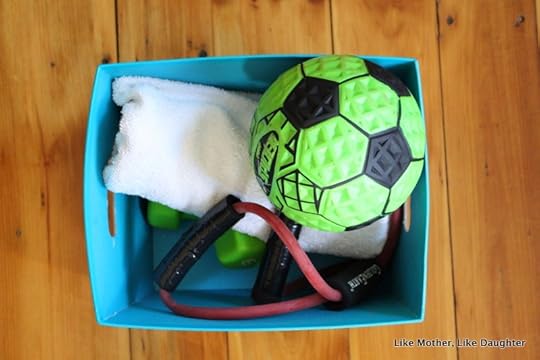
Let’s just say I’m not the tallest gal on the block, nor the one with the sturdiest build. And my babies haven’t been the smallest. Add to that the fact that, before childbearing, I never put much effort into maintaining core strength, and the result was a sad state of affairs in my midsection after Peabodee’s birth.
During my first pregnancy, I thought, “ooh, weird, my abs are separating.” I mentioned it a couple times, including to my midwife, but no one stopped me and informed me that that was not the norm nor the desired effect of pregnancy. What did I know? Everything about pregnancy was new to me, and I had never heard the topic of abdominal separation discussed.
But it definitely weirded me out, and I was concerned to have my stomach back in one piece after Finnabee was born. I asked for help and was given a few exercises to do at home. At my later check-ups, I specifically requested that the midwives check my midsection to see if things had bound back up again properly. They assured me that I was all better. Although I wasn’t convinced, I didn’t know what else to do but trust their assurance and move on.
Fast forward to my second pregnancy, which was under the care of a different midwife. Very early in the pregnancy the condition re-presented itself and I realized that my midsection was ill-prepared to carry another little one… who turned out to be not so little. Hello there, 9+ months of poor posture and 9+lb munchkin! Another blow. (I mean, a blow to my tummy. Obviously the munchkin himself is a blessing beyond belief!)
I finally got some clarity from this midwife and she did encourage me, after postpartum healing, to make some actual progress on regaining ground in the abdomen-strength area. The fact that there was something physically wrong really struck me when I happened to check my weight and discovered that I was below my pre-baby number, and yet looked heavier!
After several more months of casual searching, I realized that there’s a name for what I was experiencing: Diastasis Recti. It seems like a little thing, and might come off as simply a cosmetic concern, but actually it can inhibit overall health when it’s disrupting one’s whole plan to get fit, and threatens to get worse with each pregnancy if not addressed. No one told me that, for instance, standing certain ways was aggravating my condition. And when I did feel up for exercise, no one was there to tell me that there were certain exercises that I should be avoiding because they were counterproductive to my healing! Finally… I discovered Mutu.
My review of the program is below. But first, I want to talk about the habits of movement we have as women and mothers in our modern world, and how adjusting them can make a big difference in the care we’re taking of our core.
You can prepare your body for strong childbearing and/or recover after childbearing by making small adjustments in alignment.
Do you slouch throughout your day? I do! I find myself in positions that would make our old Irish Step Dance teacher turn over in her grave if she saw them.
The way that we tend to move, sit, and poise ourselves in our culture is counter-productive to our health in many ways, and especially unhelpful when it comes to building up our bodies in favor of healthy childbearing. We feel a lot of pressure to work out in order to look good and be strong. But if we spend, say, even 15% of our time in active exercising, we’re making our lives difficult by having the remaining 85% of our time be wasted or actually working against us.
If you haven’t had any babies yet, you can do a lot now to prepare to carry them well. (I was running three times a week and doing lots of walking the year that I got married, but I never did a thing to target my core! I had a tiny waist, but no idea that it was weak!)
Now that I’ve been introduced to Mutu, I realize that my habits were to slouch my way around through my day. Before kids, there were many months there that I just didn’t move enough, period (hello, desk job!). And then when I did start to move more, I wasn’t carrying myself well. Bending over instead of squatting, leaning around instead of standing up straight, flopping over instead of sitting.
When I was pregnant with Finnabee, I heard the advice that pregnant women should squat. Well, actually, we should all be squatting all the time! If you think about it, you need strong legs to support your midsection, especially when your midsection is going to be periodically increasing by up tens of pounds of extra person!
The first few weeks of Mutu (and all of it, really), are very big on building up squatting skills. I noticed a difference in walking up my stairs by week 3 — “wow, my legs are carrying me up instead of me sort of thrusting myself up in some vague way.”
So now I look for opportunities to squat. Ideally, back stays straight and your heels and thighs do the work. Core is engaged. (And yes, this is one reason why Western women have a harder time, in many ways, than women in traditional cultures when it comes to having babies — we hardly ever squat!)

Here are some more examples:
Slouching at the sink (and I do a lot of dishes!). Leaning my belly into the counter, shoulders usually high and tense, all the pressure going right into my mid-section, no support from my legs. Bad.
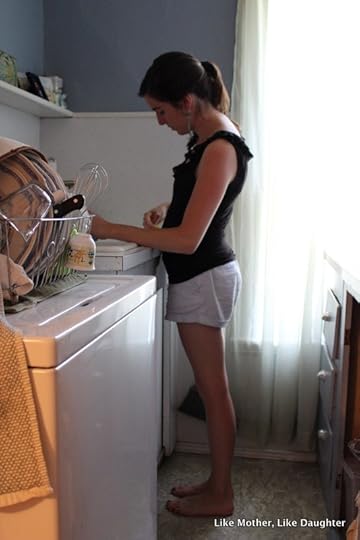
Instead: Setting my feet under my hips, rolling my shoulders back, engaging my core, lifting my chin, untucking my tail bone. Better!
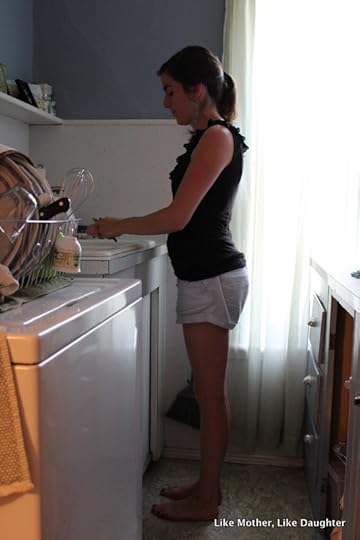
Slouching on the couch. Flopping down and leaning back with my weight gathering into my pelvis and hips, back curved around. Shoulders rolling forward. Not doing myself any favors.
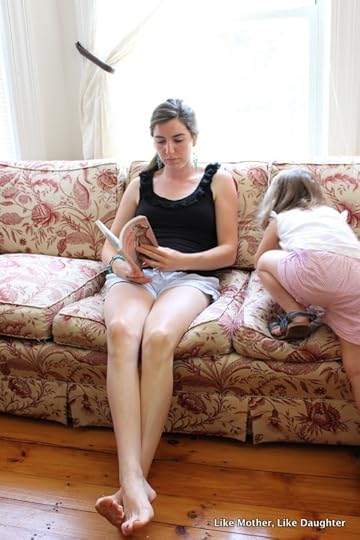
Instead: sitting so that my weight is on my “sit bones” (as they’re referred to in Mutu). In this case, sitting cross-legged so that I can relax my legs while also sitting down on my bum instead of back into a rolled-up position with my ribs collapsing towards my pelvis. Back straight, shoulders down. Not only am I improving blood flow to my head, but I’m taking pressure off of my mid-section by using my skeleton properly. Better!

Slouching in a chair (and especially at the computer!). Again, my skeleton is just flopping back, ribs caving in, and I’m not sitting upon my bum the way I should be. You can see how this is putting undo pressure on my tummy… and nor is it flattering!
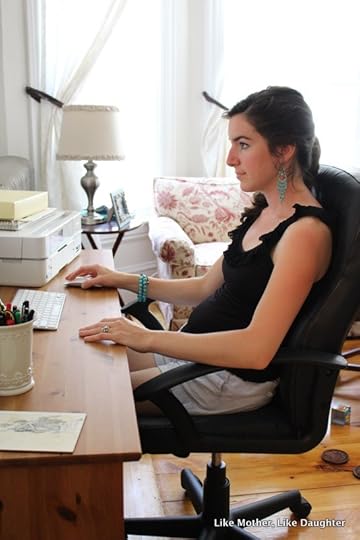
Instead: Sitting on the edge of my chair so that my feet are down on the floor, bracing me and providing support. Back straightened up, bum bones engaged, shoulders rolled down. (I can see that I still need to work on the alignment of my chin…) Better!
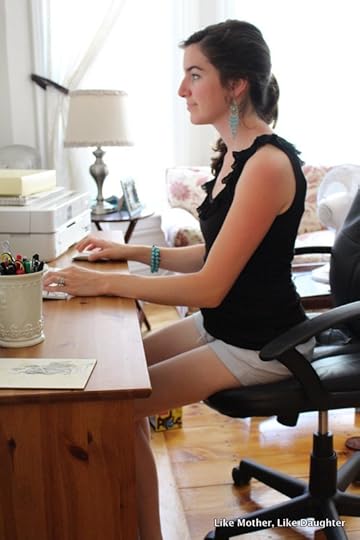
This is one I catch myself at all the time: when I need to reach something that’s slightly low but not really low. If I reach all the way down to the floor, I might remember to squat down instead of bending/flopping over. But when it’s not a far reach, just a little reach… I simply slouch, belly first! It’s so bad! I find myself doing then when buckling baby into high chair.
Instead: squat a little. Yes, it looks goofy (un-tuck the tailbone = rear does stick out a bit)! But it’s not as though I looked good when I was slouching, is it?
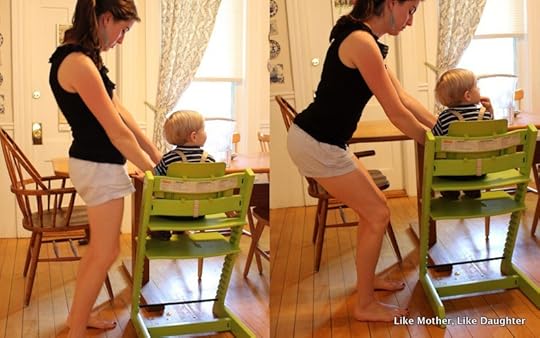
Another big one: (although I don’t have pictures): carrying the baby. It’s so easy to plop the baby on the hip, letting both hips thrust forward and one to the side, the back curving and belly going out with them. Better: square the hips over the feet, straighten up the back and roll the shoulders down, and hold the baby with the strength of the arm. This is also where proper baby-wearing comes in so handy to prevent bad posture!
I learned about all of this mainly from the Mutu System. I also found the blog Diastasis Rectified extremely helpful and have picked up a thing or two from Nutritional Movement (thanks, Rebekah, for the recommendation!). Spend a day thinking about how you move around your normal, everyday spaces and how you carry yourself. If you’re like me, you’ll find many areas where you can make small changes that will add up to a big difference in your ability to keep a strong core. I’m not going to advocate getting rid of all of the chairs in your home. But lesser changes have made a big difference to me, and now I see how much sense it makes for those of us who want to be up for childrearing in the long-term.
My Review of the Mutu System 12 Week Program
So, about Mutu. Down to the details.
Right off the bat, I will say that I’m a believer. I went into Mutu with the primary goal of closing my Diastasis Recti gap, which was about 2.5 finger widths wide when I began. I went through 9 weeks very faithfully, and then dropped off the bandwagon due to some things beyond my control. I have now dipped back in, starting at week 4.
My results? My DR gap is closed. I think I can still use some strengthening to work towards it staying closed the next time around, but I am very pleased with where it’s at and certain that I was not going to get there without a focused routine and guidance. I also have ab muscles that I’ve never had before (not that one can tell to look at me) and better overall strength. (After all these squats of every description, I’m basically like Jason Varitek over here.)
What is the System, exactly?
The Mutu System is an exercise program and, for lack of a less absurd term, “lifestyle plan” geared towards helping women close DR, regain core strength, lose baby weight, flatten tummies, and address pelvic floor issues (like “leaky undercarriage”).
You buy a subscription to the “system” and you have access to 12 weeks worth of videos and accompanying materials (as well as the Mutu Mamas Facebook group in case you want to chat with other women in the program/who have DR/who have other post-partum-physical issues). It’s designed to be done in 12 weeks, but the subscription never expires and you’ll always have access to it. Ideally, after following it for the 12 weeks, you’re strong and healed (or well on your way to healing) and can just keep it up as it suits you and your schedule, indefinitely.
The program is designed by Wendy Powell, who walks you through everything like a pal, with a manner that I must say is an impressive mix of encouraging and challenging (but mostly encouraging – there’s a very strong “you can do it, mama!” vibe throughout all the materials). She’s British and has a lovely accent and clear, calm, authoritative way of talking and presenting the material. She’s pleasant and likeable and looks inspiringly great without coming off as aggressive or immodest.
There are “core” exercises and “intensive” exercises. The core exercises are to be done every day; the intensives are sprinkled throughout the week on your schedule. There are demo videos and written guides for each one, and then videos that are paced so that you can work out “to” them. You have your own account with a module that helps you record where you are in the 12 week plan.
It’s called a “system” because there are other elements besides just the workout videos. Let me walk through them:
Core exercises. These are what I think of as “low-commitment” exercises. Yes, you need to do them twice on a daily basis. But they don’t take long, you don’t have to do them all at once, and — crucially for me — you don’t have to change clothes before hand or shower afterwards. I like to do them all at once, which means pulling up the video and running through it, then re-playing it and doing it again — takes 15 minutes. I do this during Peabodee’s naptime and Finnabee likes to do it with me. Not a big deal, once it’s in the routine, and boy does it make a difference in core strength!
Intensive exercises. These are a bit more of a commitment. Each one takes about 20 minutes and they will work up a sweat. I still do them in my living room – there’s no running or jumping – but I do change clothes to do them, so there’s that added effort.
Alignment. This has to do with the things I discussed above: learning better ways to sit, walk, move, etc. Really committing to this means ceasing to wear heeled shoes and embracing shoes that permit the natural rolling of the foot from heel to toe with every stride (or going barefoot). (Yes I did this, although I will wear heels on occasion for short periods of time, now that I’m stronger. And I’m more conscious about how they’re working against me. I’m a barefoot girl in general, so this wasn’t a big deal for me.)
In addition, Wendy encourages that you go on a ~20 min walk every day. It’s a way to build movement into your routine and actively practice proper alignment so that it becomes built into your muscle memory. She also talks about proper stride for running, further on in the program.
Eating. There is a “Mutu Food guide” that basically outlines healthy habits. For the most part, it’s about cutting out badly processed food and getting into whole foods. Drinking lots of water, getting healthy fats, and finding ways to incorporate healthy grains, etc. are other elements. This wasn’t a huge deal to me, because most of this was already part of my life. What was a big shift was the choice to cut refined sugar out of my daily diet — something that would have been unthinkable to me a few years ago but which, I have to say, did feel really great.
Breathing. This is tied into the exercise parts, above. As in pilates, there are important instructions as to how to coordinate inhaling and exhaling with each exercise move so that your muscles are properly engaged and challenged, and so that you’re not aggravating any bad muscle patterns. The big thing for me here is learning how to engage your TVA (transverse abdominal muscles): in case you were ever tempted to look thinner by “sucking in,” you can quit that habit right now! (I learned that engaging the core muscles happens on the exhale.) Wendy shows you how to engage the core properly so that you can be protecting that area, practicing all the time, and constantly working to strengthen those muscles, no matter what you’re doing.
There is also some material for learning deep-breathing relaxation, and understanding how this ties into your overall health and weight-loss efforts. But it’s just a small aspect.
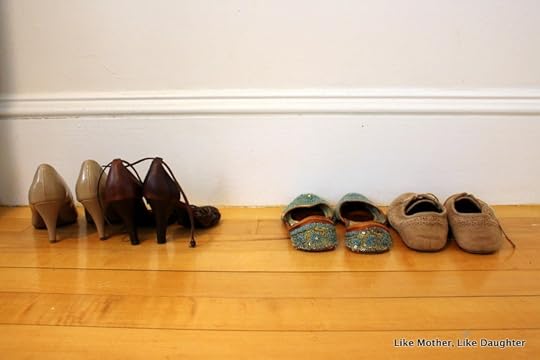
Is it realistic for a busy mom?
Well, it is a) designed to be done entirely at home and b) largely just a matter of incorporating changes into your existing routine (e.g., getting out for a walk, eating differently, perhaps).
I find that it is realistic for me, for the current season of my family life — but it is a commitment. Before I even started the program I took at least a few days to poke around the site a little, watch a couple of videos, and make a mental plan. I had to build it into my schedule. And I had to really want the results.
(Rosie says that it was a bit much with her three when she gave it a first go-round, but she’s approaching it differently a second time around and is doing better.)
I like the fact that the core exercises, which are such a big part of it, are not disruptive to the flow of the day (again, not only are you not going to the gym, but as long as you’re dressed comfortably, you don’t even have to change clothes). But even these require a certain level of determination on your part. We all know that it can be hard to set aside 15 minutes for anything on a regular basis! But once you do so, and you build it into your routine, it’s not that big of a deal.
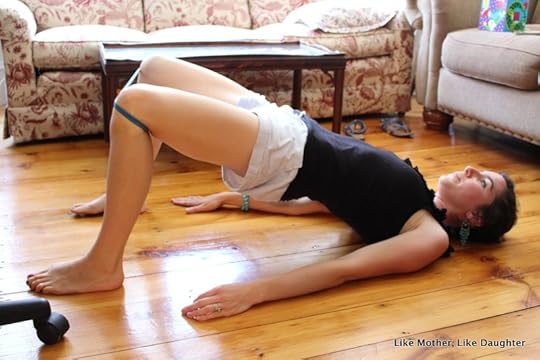
A doable approach
Wendy eases you in. Week 1 struck me as peaceful and gentle – not overwhelming in the least. Week 2? I can totally do this. I’m pretty sure anyone can do this. Week 3? A bit surprised by the first Intensive workout and a bit sore after! By week 4 I was engaged and already feeling so much stronger and more alive – and by then I was already a third of the way done!
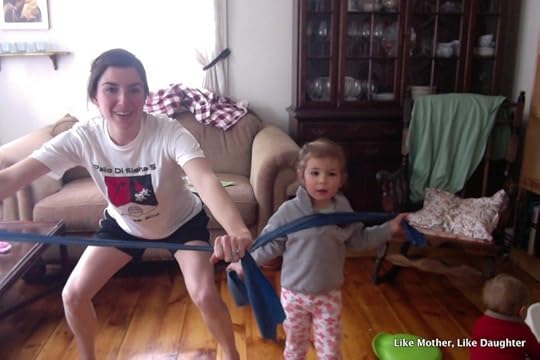
Bottom line: Is it worth it?
If you are already physically fit, or don’t have any issues specifically relating to post-partum physical health (like ab separation or pelvic floor weakness), then you might be better off just figuring out whatever core strength exercises would be good for you and going with them. (And I do recommend that you do get/keep a strong core, so that you won’t run into these problems when/if you do have a baby!) If you are looking at post-partum issues, as I was, and really just need a tool to walk you through the steps to building that strength back up and healing those specific problems, I do give Mutu a strong recommendation.
I had enough questions and concerns that I really needed someone to just stand there and tell me what to do. I also liked the aspect that I could log onto the Facebook group if necessary to get clarification on anything, because I like to know why I’m doing a given exercise or whether I’m doing it correctly. Short of having a personal trainer and DR specialist come to my home on a daily basis, this really seems to be to be the best possible option for someone in my position. (And actually, a personal trainer would be more difficult to schedule!)
As I said, my DR is basically healed. I have a much stronger core than I have possibly in my whole life. Another benefit that I experienced while in the midst of the program was a major energy boost: Getting out for a walk, whether it’s sunny or cold, is just a great habit in any case and good for the psyche; focusing on eating healthy, energizing food and no sugar really did wonders; and the habit of daily moving, exercising, and stretching were obviously generating good blood flow, etc. It was work, but very rewarding!
It’s not going to be a magic trick for tummy-flattening. For one thing (for most of us), there are some changes to the stomach from childbearing that nothing is going to undo. Mutu did help me reclaim the shape of my core, but day to day and throughout the month, I still vary in whether I look a little dumpy around the mid-section. (I’m now figuring out that I may have some gut health issues to sort out, as my problem is bloating — I know that I’m not carrying extra weight.)
In full disclosure, I did receive a complimentary subscription in exchange for this review. Not only could my perception of the program be different, not having paid for it, but it also gave me extra motivation to do it well, because I wanted to make sure I was giving it the true college try so that I could tell you about it with accuracy.
Looking back, though, I can honestly say that I would definitely feel that it was worth the money to me, if I’d have paid for it (or at least bought the abridged version, the Focus Program – and I was looking at sale prices). Someone else could get the same results on her own, but I know that I needed help.
It’s also worth noting that, unless you happen to have all the equipment handy already, you’ll pay for more than just the program itself. You will also need a small ball and a few different types of pilates bands/loops, as well as small weights. There are a few other big objects that you can improvise, but a big exercise ball would be useful as well.
Speaking of sales — I wanted to write this post now so that, if you’re interested, you could take advantage of an upcoming sale: the programs will be 45% off on July 6!
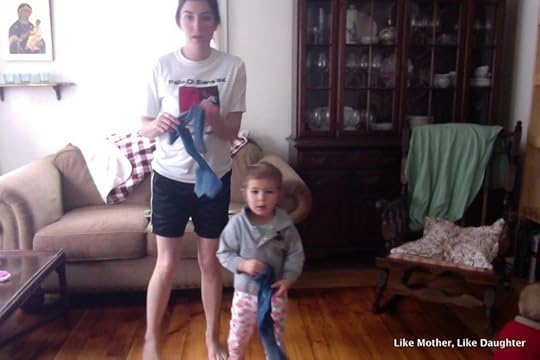
Any tips for success?
If you’re gonna do it, plan for it. Don’t try to start it tomorrow without having thought through how it’ll fit into your days and weeks.
I did a lot of my Intensives at night after the kids went to bed. Otherwise, I did them during nap times or on the weekend when the kids were occupied with Dad.
Do the homework on the Intensives before jumping in. Once I realized that there were actually only 5 exercises and I was just doing them over and over, they became much more doable. But they caught me off guard at first.
The core exercises are fine to do with your bigger kids in tow, but I found (and I know that Rosie did too) that they’re just not going to work with the baby/little toddler in the room. Too much temptation to sit on Mommy’s head/lie across Mommy’s back/play the drum on Mommy’s tummy.
It really helps if you can enlist your wonderful husband to see you through some of the workouts you don’t want to do. There were several nights when I said, “I could do my Intensive… or I could just sit here,” and the Artist stood up and said, “I’ll do it with you.” Clutch.
Here’s to having babies, healthily!
I hope I’m remembering everything… I will respond in the comments if you have any questions! This time around, the links above are affiliate links, which means I’ll get a bit if you end up purchasing a Mutu program after clicking through – so thank you!
What other tips do you have for staying strong in order to/while rais(ing) a family?
{You might also be interested in: Ask Auntie Leila: Five Steps to Feeling Pretty After the Baby)
Save
Save
Save
Save
Save
Save
Save
Save
Save
Save
Save
Save
Save
Save
The post Taking Care of Your Core, Before and After Baby – And my Mutu Review appeared first on Like Mother Like Daughter.



